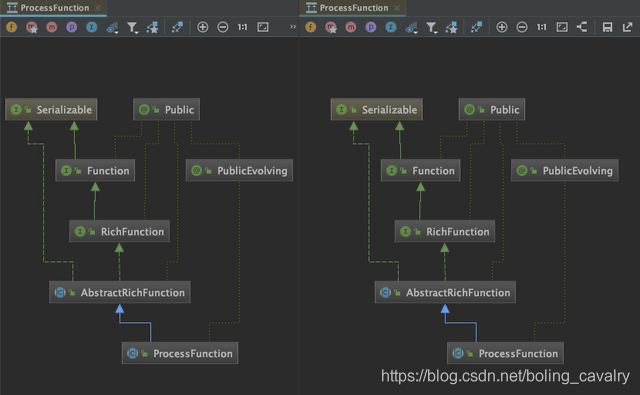Flink处理函数实战之三:KeyedProcessFunction类
欢迎访问我的GitHub
https://github.com/zq2599/blog_demos
内容:所有原创文章分类汇总及配套源码,涉及Java、Docker、Kubernetes、DevOPS等;
Flink处理函数实战系列链接
- 深入了解ProcessFunction的状态操作(Flink-1.10);
- ProcessFunction;
- KeyedProcessFunction类;
- ProcessAllWindowFunction(窗口处理);
- CoProcessFunction(双流处理);
本篇概览
本文是《Flink处理函数实战》系列的第三篇,上一篇《Flink处理函数实战之二:ProcessFunction类》学习了最简单的ProcessFunction类,今天要了解的KeyedProcessFunction,以及该类带来的一些特性;
关于KeyedProcessFunction
通过对比类图可以确定,KeyedProcessFunction和ProcessFunction并无直接关系:

KeyedProcessFunction用于处理KeyedStream的数据集合,相比ProcessFunction类,KeyedProcessFunction拥有更多特性,官方文档如下图红框,状态处理和定时器功能都是KeyedProcessFunction才有的:

介绍完毕,接下来通过实例来学习吧;
版本信息
- 开发环境操作系统:MacBook Pro 13寸, macOS Catalina 10.15.3
- 开发工具:IDEA ULTIMATE 2018.3
- JDK:1.8.0_211
- Maven:3.6.0
- Flink:1.9.2
源码下载
如果您不想写代码,整个系列的源码可在GitHub下载到,地址和链接信息如下表所示(https://github.com/zq2599/blog_demos):
| 名称 | 链接 | 备注 |
|---|---|---|
| 项目主页 | https://github.com/zq2599/blog_demos | 该项目在GitHub上的主页 |
| git仓库地址(https) | https://github.com/zq2599/blog_demos.git | 该项目源码的仓库地址,https协议 |
| git仓库地址(ssh) | git@github.com:zq2599/blog_demos.git | 该项目源码的仓库地址,ssh协议 |
这个git项目中有多个文件夹,本章的应用在flinkstudy文件夹下,如下图红框所示:

实战简介
本次实战的目标是学习KeyedProcessFunction,内容如下:
- 监听本机9999端口,获取字符串;
- 将每个字符串用空格分隔,转成Tuple2实例,f0是分隔后的单词,f1等于1;
- 上述Tuple2实例用f0字段分区,得到KeyedStream;
- KeyedSteam转入自定义KeyedProcessFunction处理;
- 自定义KeyedProcessFunction的作用,是记录每个单词最新一次出现的时间,然后建一个十秒的定时器,十秒后如果发现这个单词没有再次出现,就把这个单词和它出现的总次数发送到下游算子;
编码
- 继续使用《Flink处理函数实战之二:ProcessFunction类》一文中创建的工程flinkstudy;
- 创建bean类CountWithTimestamp,里面有三个字段,为了方便使用直接设为public:
package com.bolingcavalry.keyedprocessfunction;
public class CountWithTimestamp {
public String key;
public long count;
public long lastModified;
}
- 创建FlatMapFunction的实现类Splitter,作用是将字符串分割后生成多个Tuple2实例,f0是分隔后的单词,f1等于1:
package com.bolingcavalry;
import org.apache.flink.api.common.functions.FlatMapFunction;
import org.apache.flink.api.java.tuple.Tuple2;
import org.apache.flink.util.Collector;
import org.apache.flink.util.StringUtils;
public class Splitter implements FlatMapFunction<String, Tuple2<String, Integer>> {
@Override
public void flatMap(String s, Collector<Tuple2<String, Integer>> collector) throws Exception {
if(StringUtils.isNullOrWhitespaceOnly(s)) {
System.out.println("invalid line");
return;
}
for(String word : s.split(" ")) {
collector.collect(new Tuple2<String, Integer>(word, 1));
}
}
}
- 最后是整个逻辑功能的主体:ProcessTime.java,这里面有自定义的KeyedProcessFunction子类,还有程序入口的main方法,代码在下面列出来之后,还会对关键部分做介绍:
package com.bolingcavalry.keyedprocessfunction;
import com.bolingcavalry.Splitter;
import org.apache.flink.api.common.state.ValueState;
import org.apache.flink.api.common.state.ValueStateDescriptor;
import org.apache.flink.api.java.tuple.Tuple;
import org.apache.flink.api.java.tuple.Tuple2;
import org.apache.flink.configuration.Configuration;
import org.apache.flink.streaming.api.TimeCharacteristic;
import org.apache.flink.streaming.api.datastream.DataStream;
import org.apache.flink.streaming.api.environment.StreamExecutionEnvironment;
import org.apache.flink.streaming.api.functions.AssignerWithPeriodicWatermarks;
import org.apache.flink.streaming.api.functions.KeyedProcessFunction;
import org.apache.flink.streaming.api.watermark.Watermark;
import org.apache.flink.util.Collector;
import java.text.SimpleDateFormat;
import java.util.Date;
/**
* @author will
* @email zq2599@gmail.com
* @date 2020-05-17 13:43
* @description 体验KeyedProcessFunction类(时间类型是处理时间)
*/
public class ProcessTime {
/**
* KeyedProcessFunction的子类,作用是将每个单词最新出现时间记录到backend,并创建定时器,
* 定时器触发的时候,检查这个单词距离上次出现是否已经达到10秒,如果是,就发射给下游算子
*/
static class CountWithTimeoutFunction extends KeyedProcessFunction<Tuple, Tuple2<String, Integer>, Tuple2<String, Long>> {
// 自定义状态
private ValueState<CountWithTimestamp> state;
@Override
public void open(Configuration parameters) throws Exception {
// 初始化状态,name是myState
state = getRuntimeContext().getState(new ValueStateDescriptor<>("myState", CountWithTimestamp.class));
}
@Override
public void processElement(
Tuple2<String, Integer> value,
Context ctx,
Collector<Tuple2<String, Long>> out) throws Exception {
// 取得当前是哪个单词
Tuple currentKey = ctx.getCurrentKey();
// 从backend取得当前单词的myState状态
CountWithTimestamp current = state.value();
// 如果myState还从未没有赋值过,就在此初始化
if (current == null) {
current = new CountWithTimestamp();
current.key = value.f0;
}
// 单词数量加一
current.count++;
// 取当前元素的时间戳,作为该单词最后一次出现的时间
current.lastModified = ctx.timestamp();
// 重新保存到backend,包括该单词出现的次数,以及最后一次出现的时间
state.update(current);
// 为当前单词创建定时器,十秒后后触发
long timer = current.lastModified + 10000;
ctx.timerService().registerProcessingTimeTimer(timer);
// 打印所有信息,用于核对数据正确性
System.out.println(String.format("process, %s, %d, lastModified : %d (%s), timer : %d (%s)\n\n",
currentKey.getField(0),
current.count,
current.lastModified,
time(current.lastModified),
timer,
time(timer)));
}
/**
* 定时器触发后执行的方法
* @param timestamp 这个时间戳代表的是该定时器的触发时间
* @param ctx
* @param out
* @throws Exception
*/
@Override
public void onTimer(
long timestamp,
OnTimerContext ctx,
Collector<Tuple2<String, Long>> out) throws Exception {
// 取得当前单词
Tuple currentKey = ctx.getCurrentKey();
// 取得该单词的myState状态
CountWithTimestamp result = state.value();
// 当前元素是否已经连续10秒未出现的标志
boolean isTimeout = false;
// timestamp是定时器触发时间,如果等于最后一次更新时间+10秒,就表示这十秒内已经收到过该单词了,
// 这种连续十秒没有出现的元素,被发送到下游算子
if (timestamp == result.lastModified + 10000) {
// 发送
out.collect(new Tuple2<String, Long>(result.key, result.count));
isTimeout = true;
}
// 打印数据,用于核对是否符合预期
System.out.println(String.format("ontimer, %s, %d, lastModified : %d (%s), stamp : %d (%s), isTimeout : %s\n\n",
currentKey.getField(0),
result.count,
result.lastModified,
time(result.lastModified),
timestamp,
time(timestamp),
String.valueOf(isTimeout)));
}
}
public static void main(String[] args) throws Exception {
final StreamExecutionEnvironment env = StreamExecutionEnvironment.getExecutionEnvironment();
// 并行度1
env.setParallelism(1);
// 处理时间
env.setStreamTimeCharacteristic(TimeCharacteristic.ProcessingTime);
// 监听本地9999端口,读取字符串
DataStream<String> socketDataStream = env.socketTextStream("localhost", 9999);
// 所有输入的单词,如果超过10秒没有再次出现,都可以通过CountWithTimeoutFunction得到
DataStream<Tuple2<String, Long>> timeOutWord = socketDataStream
// 对收到的字符串用空格做分割,得到多个单词
.flatMap(new Splitter())
// 设置时间戳分配器,用当前时间作为时间戳
.assignTimestampsAndWatermarks(new AssignerWithPeriodicWatermarks<Tuple2<String, Integer>>() {
@Override
public long extractTimestamp(Tuple2<String, Integer> element, long previousElementTimestamp) {
// 使用当前系统时间作为时间戳
return System.currentTimeMillis();
}
@Override
public Watermark getCurrentWatermark() {
// 本例不需要watermark,返回null
return null;
}
})
// 将单词作为key分区
.keyBy(0)
// 按单词分区后的数据,交给自定义KeyedProcessFunction处理
.process(new CountWithTimeoutFunction());
// 所有输入的单词,如果超过10秒没有再次出现,就在此打印出来
timeOutWord.print();
env.execute("ProcessFunction demo : KeyedProcessFunction");
}
public static String time(long timeStamp) {
return new SimpleDateFormat("yyyy-MM-dd hh:mm:ss").format(new Date(timeStamp));
}
}
上述代码有几处需要重点关注的:
- 通过assignTimestampsAndWatermarks设置时间戳的时候,getCurrentWatermark返回null,因为用不上watermark;
- processElement方法中,state.value()可以取得当前单词的状态,state.update(current)可以设置当前单词的状态,这个功能的详情请参考《深入了解ProcessFunction的状态操作(Flink-1.10)》;
- registerProcessingTimeTimer方法设置了定时器的触发时间,注意这里的定时器是基于processTime,和官方demo中的eventTime是不同的;
- 定时器触发后,onTimer方法被执行,里面有这个定时器的全部信息,尤其是入参timestamp,这是原本设置的该定时器的触发时间;
验证
- 在控制台执行命令nc -l 9999,这样就可以从控制台向本机的9999端口发送字符串了;
- 在IDEA上直接执行ProcessTime类的main方法,程序运行就开始监听本机的9999端口了;
- 在前面的控制台输入aaa,然后回车,等待十秒后,IEDA的控制台输出以下信息,从结果可见符合预期:

- 继续输入aaa再回车,连续两次,中间间隔不要超过10秒,结果如下图,可见每一个Tuple2元素都有一个定时器,但是第二次输入的aaa,其定时器在出发前,aaa的最新出现时间就被第三次输入的操作给更新了,于是第二次输入aaa的定时器中的对比操作发现此时距aaa的最近一次(即第三次)出现还未达到10秒,所以第二个元素不会发射到下游算子:

- 下游算子收到的所有超时信息会打印出来,如下图红框,只打印了数量等于1和3的记录,等于2的时候因为在10秒内再次输入了aaa,因此没有超时接收,不会在下游打印:

至此,KeyedProcessFunction处理函数的学习就完成了,其状态读写和定时器操作都是很实用能力,希望本文可以给您提供参考;
你不孤单,欣宸原创一路相伴
欢迎关注公众号:程序员欣宸
微信搜索「程序员欣宸」,我是欣宸,期待与您一同畅游Java世界...
https://github.com/zq2599/blog_demos
Flink处理函数实战之三:KeyedProcessFunction类的更多相关文章
- Flink处理函数实战之二:ProcessFunction类
欢迎访问我的GitHub https://github.com/zq2599/blog_demos 内容:所有原创文章分类汇总及配套源码,涉及Java.Docker.Kubernetes.DevOPS ...
- Flink处理函数实战之五:CoProcessFunction(双流处理)
欢迎访问我的GitHub https://github.com/zq2599/blog_demos 内容:所有原创文章分类汇总及配套源码,涉及Java.Docker.Kubernetes.DevOPS ...
- Flink处理函数实战之一:深入了解ProcessFunction的状态(Flink-1.10)
欢迎访问我的GitHub https://github.com/zq2599/blog_demos 内容:所有原创文章分类汇总及配套源码,涉及Java.Docker.Kubernetes.DevOPS ...
- Flink处理函数实战之四:窗口处理
欢迎访问我的GitHub https://github.com/zq2599/blog_demos 内容:所有原创文章分类汇总及配套源码,涉及Java.Docker.Kubernetes.DevOPS ...
- Flink的sink实战之三:cassandra3
欢迎访问我的GitHub https://github.com/zq2599/blog_demos 内容:所有原创文章分类汇总及配套源码,涉及Java.Docker.Kubernetes.DevOPS ...
- Flink的sink实战之一:初探
欢迎访问我的GitHub https://github.com/zq2599/blog_demos 内容:所有原创文章分类汇总及配套源码,涉及Java.Docker.Kubernetes.DevOPS ...
- Flink的sink实战之二:kafka
欢迎访问我的GitHub https://github.com/zq2599/blog_demos 内容:所有原创文章分类汇总及配套源码,涉及Java.Docker.Kubernetes.DevOPS ...
- Flink的sink实战之四:自定义
欢迎访问我的GitHub https://github.com/zq2599/blog_demos 内容:所有原创文章分类汇总及配套源码,涉及Java.Docker.Kubernetes.DevOPS ...
- Flink的DataSource三部曲之三:自定义
欢迎访问我的GitHub https://github.com/zq2599/blog_demos 内容:所有原创文章分类汇总及配套源码,涉及Java.Docker.Kubernetes.DevOPS ...
随机推荐
- 【API管理 APIM】APIM中对后端API服务的DNS域名缓存问题
问题描述 在使用API Management来进行API管理时,当我们后端的API DNS IP地址发生改变或者是API的域名发生改变后,通过APIM请求访问的还是是旧的域名或者IP地址,这是因API ...
- LIS初级推算(最长上升子序列问题)
所谓LIS,就是Longest Increasing Subsequence问题 注意,子序列不一定是连续的,举个例子:对于序列10,9,2,3,5,4,7,9,101,18,其中的LIS就是2,3, ...
- Maven1详解
Maven详解(一)------ Maven概述 目录 1.引言 2.常规项目开发存在的问题 3.什么是 Maven ? 4.Maven 的历史 5.Maven 的目标 6.Maven 的理念 回 ...
- Foundation 用于开发响应
Foundation 用于开发响应式的 HTML, CSS and JavaScript 框架. Foundation 是一个易用.强大而且灵活的框架,用于构建基于任何设备上的 Web 应用. Fou ...
- 利用transformer进行中文文本分类(数据集是复旦中文语料)
利用TfidfVectorizer进行中文文本分类(数据集是复旦中文语料) 利用RNN进行中文文本分类(数据集是复旦中文语料) 利用CNN进行中文文本分类(数据集是复旦中文语料) 和之前介绍的不同,重 ...
- selenium中如何保证操作元素的成功率?也就是说如何保证我点击的元素一定是可以点击的?
1.在寻找元素时,加上显示等待或者隐式等待,这样在对元素进行操作之前保证元素被找到,进而提高成功率: 2.在对元素操作之前,比如click,如果该元素未display(非hidden),就需要先滚动到 ...
- k8s部署之系统初始化(一)
初始化 1.安装依赖包 yum -y install tree lrzsz nmap nc telnet vim wget lsof network-tools bash-completion bas ...
- php的三元运算符
简单记录一哈php的三元运算符的用法: 啥子是三元运算,即第一个表达式作为判断条件,在后面两个表达式中选择一个执行. 若判断成立,则执行第二个表达式,否则执行第三个表达式. 看到好多网友都说的不 ...
- 【面经】面试官:如何以最高的效率从MySQL中随机查询一条记录?
写在前面 MySQL数据库在互联网行业使用的比较多,有些小伙伴可能会认为MySQL数据库比较小,存储不了很多的数据.其实,这些小伙伴是真的不了解MySQL.MySQL的小不是说使用MySQL存储的数据 ...
- Linux sar命令参数详解
转载自http://www.chinaz.com/server/2013/0401/297942.shtml sar(System Activity Reporter系统活动情况报告)是目前 Linu ...
